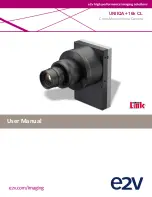
5
16.37
0.144
6.62x10
16
17.25 15.5 17.5 15.37
18
15.12 18.62 14.5
19.5
4.5
16
0.147
6.5x9.75
15.5 16.62 15.25
17
15
17.25 14.62
18
14.37 18.87
4
15.62
0.150
6.37x9.5 14.75
16
14.62 16.12 14.37 16.62
14
17.12 13.62 17.87
3.5
15.25
0.155
6.12x9.12 14.37 15.5 14.25 15.75 13.87 16.37 13.5 16.75 13.25 17.12
* Measured from the subject to the focal plane; this corresponds approximately to the rear upper edge of the
camera top.
CLOSE-UP FOCUSING WITH THE NI AND NII LENSES COMBINED
(For Conversion into metric units, see page 62)
Set
Focusing
Scale of
Camera
to (feet)
Subject
Distance*
(inches)
Scale of
Reproduction
Field Size
in Inches
Depth of Field* in inches at Aperture
f
5.6
f
8
f
11
f
16
f
22
from
to
from
to
from
to
from
to
from
to
inf
14.62
0.163
5.75x8.5
14
14.87 13.75 15.12 13.5 15.25 13.25 15.62
13
16.25
25
14.12
0.175
5.37x8.25 13.75 14.62 13.62 14.75 13.37
15
13.12 15.5 12.75
16
15
13.75
0.178
5.25x8.12 13.37 14.12 13.25 14.25
13
14.5 12.62
15
12.5 15.37
10
13.5
0.182
5.12x7.87 13.25
14
13
14.12 12.75 14.25 12.5 14.75 12.25 15.12
8
13.37
0.185
5.12x7.75 13.12 13.75 12.87 13.87 12.62 14.12 12.37 14.62 12.12
15
7
13.25
0.187
5.12x7.62
13
13.5 12.75 13.75 12.5
14
12.37 14.37
12
14.75
6
13.12
0.189
5x7.5
12.75 13.37 12.62 13.5 12.37 13.75 12.25 14.12 11.87 14.5
5
12.75
0.195
4.87x7.25 12.62 13.25 12.37 13.37 12.25 13.5 12.12 13.87 11.75 14.25
4.5
12.62
0.199
4.87x7.12 12.5
13
12.25 13.12
12
13.37 11.87 13.62 11.62
14
4
12.5
0.204
4.75x6.87 12.37 12.75 12.12
13
11.87 13.25 11.37 13.5 11.5 13.75
3.5
12.25
0.211
4.5x6.75 12.12 12.37
12
12.62 11.75 13.12 11.25
13
11
13.5
* Measured from the subject to the focal plane; this corresponds approximately to the rear upper edge of the
camera top.
The Table Stand
The table stand is designed for close-up subjects which allow or need longer exposure times as well as for all types
of close-ups where quick setting up and absolute steadiness of the camera are important.
The stand consists of a U-shaped base with an adjustable column and a ball and socket head. The stand can be
taken to pieces for easy transport and storage. It is specially useful for close-ups with the close-up N lenses, with or
without the close-up rangefinder.
A right-angle head is available for the table stand for mounting the camera so that it mounts vertically downwards
for copying.
The Technique of Exposure
The correct exposure time depends on two factors:
(1) The amount and colour of light reflected from the object to be photographed. This in its turn depends on the
season of the year, the time of day, situation, weather, etc.
(2) The speed of film, filter, and lens stop employed. The correct exposure time can be ascertained with:
EXPOSURE TABLES. These are based on mathematical calculations and practical experience. Such a table is given on
page 52. The Focal Exposure Chart represents the most up-to-date quick working version of an exposure table.
OPTICAL EXPOSURE METERS. measure, with the aid of the eye, the amount of light reflected. If used consistently
and with care, they will give exposure figures well within the latitude of the film.
PHOTO-ELECTRIC EXPOSURE METERS. They are the most accurate and dependable means available for arriving at
the right exposure time.
A photo-electric exposure meter is built into the Retinette IIA and IIB cameras.
The Built-in Meter of the Retinette IB and IIA








































